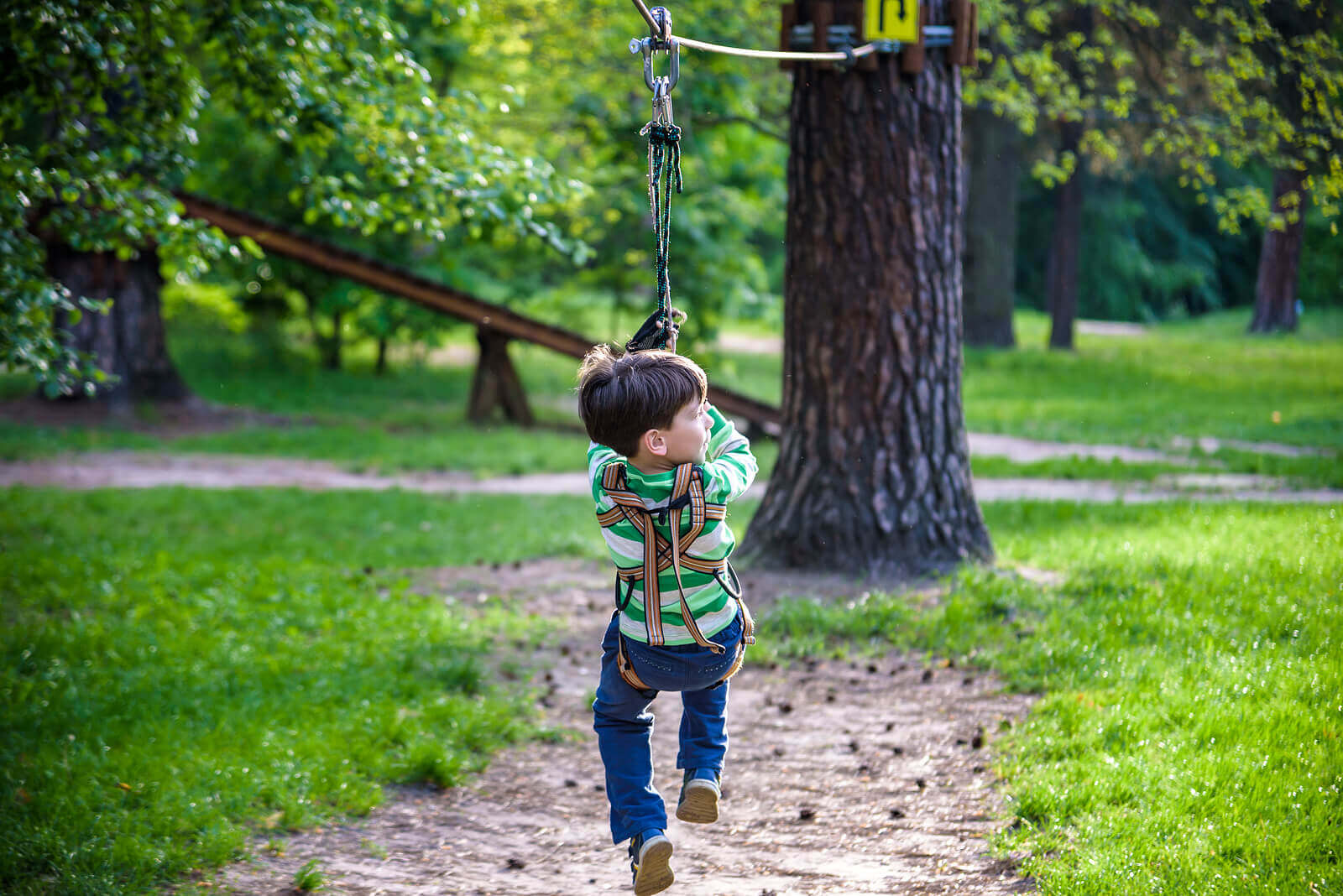The Importance of Encouraging Children to Be Active

Children are active by nature. But if we don’t give them the opportunity to be active, little by little, a sedentary lifestyle will become more and more common; television and video games will end up being the main (maybe only) means of leisure for young people. That’s why encouraging children to be active is so important.
Children who are active not only have better health and physical fitness; they also have better physical, social, cognitive and emotional development. Not giving them the opportunity to move and be physically active, in addition to promoting obesity, deprives them of harmonious and healthy development.

Why should we be encouraging children to be active?
Children can be active in many ways. Playing sports and engaging in any kind of physical activity is a very common way. But little ones also stay active by playing freely, walking around, using the stairs instead of the elevator, running errands, and even helping around the house.
Anything goes as long as they keep moving. In fact, no matter what they do to stay active, movement will bring them many benefits, including the following:
- Improved cardiovascular capacity
- Improved coordination and control of movement
- Confidence in their own abilities
- Improved self-esteem
- Reduced risk of depression, anxiety and emotional distress
- Development of strong bones and muscles
- Maintaining a healthy weight
- Reduced risk of future chronic diseases
- Improved learning and attention skills
- Increased opportunities for expression and communication
- Opportunity to develop social skills such as cooperation, respect for others, problem solving, fair play, and teamwork
10 reasons why children should be active
According to the American Council on Exercise, the main reasons why children should be active and get plenty of exercise are the following:
- Children who exercise are more likely to stay active as adults.
- Exercise helps children reach and maintain a healthy body weight.
- Regular physical activity helps develop and maintain strong, healthy muscles, bones, and joints.
- Exercise helps develop important interpersonal skills; this is especially good for participation in team sports.
- Exercise improves the amount and quality of sleep.
- Research shows that exercise promotes better school attendance and improves academic performance.
- Children who exercise have higher self-esteem and a better self-image.
- Participation in regular physical activity prevents or delays the development of many chronic diseases, for example, heart disease, diabetes, obesity, hypertension, and promotes health.
- Active children report fewer symptoms of anxiety and depression and better overall mood.
- Exercise helps improve motor coordination and enhances the development of various motor performance skills.
How can you help children be active?
The best way for children to value physical activity is to allow them to be active. It may seem simple, but it’s not. Many times children want to play and we don’t let them, either because there are other things to do or because we ourselves are lazy.
Therefore, we must take advantage of this natural impulse in children and let them move and play. However, without losing sight of respect for others and the basic rules of coexistence.

Another very effective way of encouraging children to be active is for them to see adults being active. There’s no point in telling them to move or play sports if they see adults protesting every time they have to make an effort, or spending a lot of time on the couch, watching TV, or playing mobile or video games.
Playing sports as a family is a good way to motivate children to be active. At the same time, getting children to help with household chores and set an example by walking and climbing stairs whenever possible will also give them the opportunity to move around and have fun.
In short, physical activity is essential for children. It’s not only a question of physical development, but also of mental and emotional development. Children who move are more creative because any opportunity for movement is an opportunity for play. They’re also more cheerful, which helps them manage stress and prevents anxiety and depression.
At the same time, as parents, encouraging and promoting children’s activity allows us to be more active as well. And these are opportunities we can’t miss, both to move around and to be with our children.
So, how about you? What are you waiting for to be active with your little ones?
Children are active by nature. But if we don’t give them the opportunity to be active, little by little, a sedentary lifestyle will become more and more common; television and video games will end up being the main (maybe only) means of leisure for young people. That’s why encouraging children to be active is so important.
Children who are active not only have better health and physical fitness; they also have better physical, social, cognitive and emotional development. Not giving them the opportunity to move and be physically active, in addition to promoting obesity, deprives them of harmonious and healthy development.

Why should we be encouraging children to be active?
Children can be active in many ways. Playing sports and engaging in any kind of physical activity is a very common way. But little ones also stay active by playing freely, walking around, using the stairs instead of the elevator, running errands, and even helping around the house.
Anything goes as long as they keep moving. In fact, no matter what they do to stay active, movement will bring them many benefits, including the following:
- Improved cardiovascular capacity
- Improved coordination and control of movement
- Confidence in their own abilities
- Improved self-esteem
- Reduced risk of depression, anxiety and emotional distress
- Development of strong bones and muscles
- Maintaining a healthy weight
- Reduced risk of future chronic diseases
- Improved learning and attention skills
- Increased opportunities for expression and communication
- Opportunity to develop social skills such as cooperation, respect for others, problem solving, fair play, and teamwork
10 reasons why children should be active
According to the American Council on Exercise, the main reasons why children should be active and get plenty of exercise are the following:
- Children who exercise are more likely to stay active as adults.
- Exercise helps children reach and maintain a healthy body weight.
- Regular physical activity helps develop and maintain strong, healthy muscles, bones, and joints.
- Exercise helps develop important interpersonal skills; this is especially good for participation in team sports.
- Exercise improves the amount and quality of sleep.
- Research shows that exercise promotes better school attendance and improves academic performance.
- Children who exercise have higher self-esteem and a better self-image.
- Participation in regular physical activity prevents or delays the development of many chronic diseases, for example, heart disease, diabetes, obesity, hypertension, and promotes health.
- Active children report fewer symptoms of anxiety and depression and better overall mood.
- Exercise helps improve motor coordination and enhances the development of various motor performance skills.
How can you help children be active?
The best way for children to value physical activity is to allow them to be active. It may seem simple, but it’s not. Many times children want to play and we don’t let them, either because there are other things to do or because we ourselves are lazy.
Therefore, we must take advantage of this natural impulse in children and let them move and play. However, without losing sight of respect for others and the basic rules of coexistence.

Another very effective way of encouraging children to be active is for them to see adults being active. There’s no point in telling them to move or play sports if they see adults protesting every time they have to make an effort, or spending a lot of time on the couch, watching TV, or playing mobile or video games.
Playing sports as a family is a good way to motivate children to be active. At the same time, getting children to help with household chores and set an example by walking and climbing stairs whenever possible will also give them the opportunity to move around and have fun.
In short, physical activity is essential for children. It’s not only a question of physical development, but also of mental and emotional development. Children who move are more creative because any opportunity for movement is an opportunity for play. They’re also more cheerful, which helps them manage stress and prevents anxiety and depression.
At the same time, as parents, encouraging and promoting children’s activity allows us to be more active as well. And these are opportunities we can’t miss, both to move around and to be with our children.
So, how about you? What are you waiting for to be active with your little ones?
All cited sources were thoroughly reviewed by our team to ensure their quality, reliability, currency, and validity. The bibliography of this article was considered reliable and of academic or scientific accuracy.
- Aadland, K. N., Aadland, E., Andersen, J. R., Lervåg, A., Moe, V. F., Resaland, G. K., & Ommundsen, Y. (2018). Executive function, behavioral self-regulation, and school related well-being did not mediate the effect of school-based physical activity on academic performance in numeracy in 10-year-old children. The Active Smarter Kids (ASK) study. Frontiers in Psychology, 9(FEB). https://doi.org/10.3389/fpsyg.2018.00245
- Aznar Laín, S. y Webster, T. (2006). Actividad física y salud en la infancia y la adolescencia. Ministerio de Educacion y Cultura, Centro de Investigación y Documentación educativa.
- Lisahunter, Abbott, R., Macdonald, D., Ziviani, J., & Cuskelly, M. (2014). Active kids active minds: A physical activity intervention to promote learning? Asia-Pacific Journal of Health, Sport and Physical Education, 5(2), 117–131. https://doi.org/10.1080/18377122.2014.906057
This text is provided for informational purposes only and does not replace consultation with a professional. If in doubt, consult your specialist.








